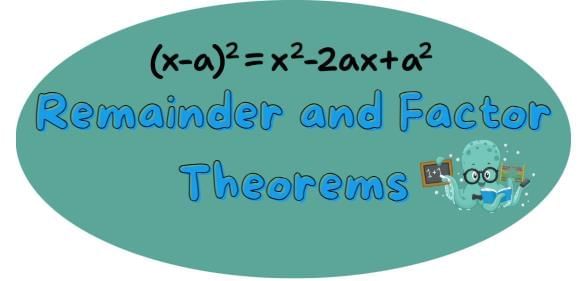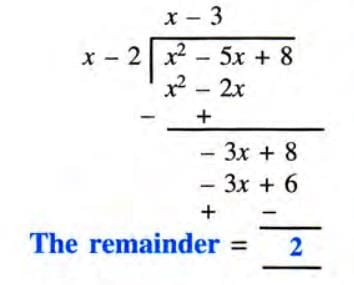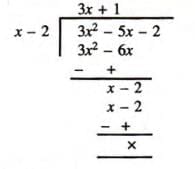Class 10 Exam > Class 10 Notes > Mathematics Class 10 ICSE > Chapter Notes: Remainder and Factor Theorems
Remainder and Factor Theorems Chapter Notes | Mathematics Class 10 ICSE PDF Download
| Table of contents |

|
| Introduction |

|
| A Basic Concept |

|
| Remainder Theorem |

|
| Factor Theorem |

|
| Using the Factor Theorem to Factorise the Given Polynomial |

|
Introduction
Dive into the fascinating world of polynomials with the Remainder and Factor Theorems, the superheroes of algebra in your Class 10 ICSE Mathematics journey! These theorems are like magic keys that unlock the secrets of polynomial division, helping you find remainders without tedious calculations and identify factors with ease. Imagine simplifying complex polynomial puzzles into neat, solvable pieces—this chapter equips you with the tools to do just that. Whether you're determining if a polynomial is divisible by a linear expression or breaking it down into its factors, these concepts make algebra both exciting and approachable. Get ready to explore a chapter that transforms the way you see polynomials!

A Basic Concept
- A polynomial f(x) is a function where the value of f(x) depends on the variable x.
- Substituting different values of x into the polynomial changes the output of f(x).
- Dividing a polynomial f(x) by a linear expression like x - a may leave a remainder.
Example: Find the remainder when f(x) = x2- 5x + 8 is divided by x - 2.


- Or we can substitute x = 2 into f(x).
- f(2) = 22 - 5 × 2 + 8 = 4 - 10 + 8 = 2.
- Remainder = 2.
Remainder Theorem
- Theorem: If a polynomial f(x) is divided by x - a, the remainder is f(a).
- Steps to find the remainder:
- Set the divisor x - a = 0 to find x = a.
- Substitute x = a into f(x) to compute f(a).
- The value of f(a) is the remainder.
Example: Find the remainder when x2- 8x + 4 is divided by 2x + 1.
- Set 2x + 1 = 0 → x = -1/2.
- Substitute x = -1/2 into f(x) = x2 - 8x + 4.
- f(-1/2) = (-1/2)2 - 8 × (-1/2) + 4 = 1/4 + 4 + 4 = 33/4.
- Remainder = 33/4.
Solved Example: Find the value of 'a' if ax3 + 9x2+ 4x - 10 divided by x + 3 leaves a remainder of 5.
- Set x + 3 = 0 → x = -3.
- Given remainder = 5, so f(-3) = 5.
- f(x) = ax3 + 9x2 + 4x - 10.
- f(-3) = a(-3)3 + 9(-3)2 + 4(-3) - 10 = -27a + 81 - 12 - 10 = 5.
- -27a + 59 = 5 → -27a = -54 → a = 2.
- Answer: a = 2.
Factor Theorem
- Theorem: If f(a) = 0 when a polynomial f(x) is divided by x - a, then x - a is a factor of f(x).
- Conversely, if x - a is a factor, then f(a) = 0.
- Steps to check if x - a is a factor:
- Compute f(a).
- If f(a) = 0, then x - a is a factor.
Example 1: Determine whether x - 1 is a factor of x6 - x5 + x4 + x3 - x2- x + 1.
- Set x - 1 = 0 → x = 1.
- Substitute x = 1: f(1) = 16 - 15 + 14 + 13 - 12 - 1 + 1 = 1 - 1 + 1 + 1 - 1 - 1 + 1 = 1.
- Since f(1) ≠ 0, x - 1 is not a factor.
Example 2: Find the value of 'k' if x - 2 is a factor of x3 + 2x2- kx + 10. Check if x + 5 is also a factor.
- Set x - 2 = 0 → x = 2.
- Since x - 2 is a factor, f(2) = 0.
- f(x) = x3 + 2x2 - kx + 10.
- f(2) = 23 + 2(2)2 - k(2) + 10 = 8 + 8 - 2k + 10 = 26 - 2k = 0.
- 2k = 26 → k = 13.
- Polynomial becomes x3 + 2x2 - 13x + 10.
- Check x + 5: Set x + 5 = 0 → x = -5.
- f(-5) = (-5)3 + 2(-5)2 - 13(-5) + 10 = -125 + 50 + 65 + 10 = 0.
- Since f(-5) = 0, x + 5 is a factor.
- Answer: k = 13, x + 5 is a factor.
Using the Factor Theorem to Factorise the Given Polynomial
- If f(a) = 0, then x - a is a factor of f(x).
- After finding one factor, divide f(x) by x - a to get a quotient polynomial.
- Factorise the quotient further if possible to completely factorise f(x).
- Steps to factorise:
- Find a value 'a' such that f(a) = 0.
- Divide f(x) by x - a to get the quotient.
- Factorise the quotient polynomial.
Example 1: Show that x - 2 is a factor of 3x2- 5x - 2 and factorise completely.

- Set x - 2 = 0 → x = 2.
- f(x) = 3x2 - 5x - 2.
- f(2) = 3(2)2 - 5(2) - 2 = 12 - 10 - 2 = 0.
- Since f(2) = 0, x - 2 is a factor.
- Divide 3x2 - 5x - 2 by x - 2:

- Quotient = 3x + 1.
- Thus, 3x2 - 5x - 2 = (x - 2)(3x + 1).
Example 2: Factorise 2x3 + x2- 13x + 6 completely using the Remainder Theorem.
- Test possible factors (factors of 6): x = ±1, ±2, ±3, ±6.
- Try x = 1: f(1) = 2(1)3 + 12 - 13(1) + 6 = 2 + 1 - 13 + 6 = -4 ≠ 0.
- Try x = 2: f(2) = 2(2)3 + 22 - 13(2) + 6 = 16 + 4 - 26 + 6 = 0.
- x - 2 is a factor.
- Divide 2x3 + x2 - 13x + 6 by x - 2: Quotient = 2x2 + 5x - 3.
- Factorise 2x2 + 5x - 3 = (2x - 1)(x + 3).
- Thus, 2x3 + x2 - 13x + 6 = (x - 2)(2x - 1)(x + 3).
The document Remainder and Factor Theorems Chapter Notes | Mathematics Class 10 ICSE is a part of the Class 10 Course Mathematics Class 10 ICSE.
All you need of Class 10 at this link: Class 10
|
74 videos|213 docs|30 tests
|
FAQs on Remainder and Factor Theorems Chapter Notes - Mathematics Class 10 ICSE
| 1. What is the Remainder Theorem and how is it used in polynomial division? |  |
Ans. The Remainder Theorem states that if a polynomial f(x) is divided by a linear divisor of the form (x - c), the remainder of this division is equal to f(c). This means you can find the remainder by simply substituting the value c into the polynomial. This theorem is useful for quickly determining the value of a polynomial at a specific point without performing the entire division.
| 2. Can you explain the Factor Theorem and its significance in polynomial factorization? |  |
Ans. The Factor Theorem is an extension of the Remainder Theorem that states a polynomial f(x) has a factor (x - c) if and only if f(c) = 0. This is significant because it allows us to identify factors of polynomials by finding their roots. If we can find a value c that makes f(c) = 0, we can use (x - c) as a factor and further factor the polynomial.
| 3. How can I use the Factor Theorem to factorize a given polynomial? |  |
Ans. To factor a polynomial using the Factor Theorem, follow these steps: First, identify potential roots by testing possible values of c. Substitute these values into the polynomial until you find one that results in f(c) = 0. Once a root is found, you can use polynomial long division or synthetic division to divide the original polynomial by (x - c), resulting in a simpler polynomial. Repeat this process with the quotient until the polynomial is completely factored.
| 4. What are some common mistakes students make when applying the Remainder and Factor Theorems? |  |
Ans. Common mistakes include incorrectly substituting values into the polynomial, misunderstanding the relationship between remainders and factors, and failing to check all possible roots. Students may also forget to confirm that a polynomial is completely factored or misinterpret the results from synthetic division. Careful attention to detail and step-by-step verification can help avoid these pitfalls.
| 5. How are the Remainder and Factor Theorems applied in real-world scenarios? |  |
Ans. The Remainder and Factor Theorems are applied in various fields such as engineering, computer science, and economics, where polynomial equations model real-world situations. For example, they can be used to analyze data trends, optimize functions, and solve problems involving rates of change. Understanding these theorems allows professionals to efficiently find solutions or simplify complex calculations in their respective fields.
Related Searches















